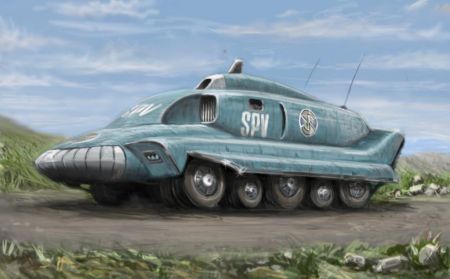Special purpose vehicle: Difference between revisions
Amwelladmin (talk | contribs) No edit summary |
Amwelladmin (talk | contribs) No edit summary |
||
| Line 1: | Line 1: | ||
{{ | {{def|Special purpose vehicle|/ˈspɛʃ(ə)l /ˈspɛʃ(ə)l ˈviːɪk(ə)l/ (also [[espievie]] (''/ɛspiːviː/'')|n|[[File:SPV.jpg|450px|thumb|center|An [[espievie]] going about its charitable purposes yesterday]]}} | ||
A unique species of [[joint stock company]]<ref>Known in accounting circles, for some reason, as an [[espiecie]] — rest assured it is the same beast.</ref> first discovered in the lush forests of [[George Town]], [[Grand Cayman]] by dour Scottish naturalist [[A. J. N. Calder]] in 1926. | |||
For many years Calder believed the creature he had found — genus ''consortium restrictum culpam caymanium'', the “Common” or “Cayman Exempted” [[Espievie]] — was unique in the world. His, and our, world was rocked when naturalists found variant species elsewhere: first not far from the Caribbean, when [[L. B. G. T. Appleby]] discovered the [[Bermudan reinsurance espievie]] in 1939, and [[Herbert Fonesca]] discovering the [[Panamanian film espievie]] in 1953, and then further afield when, in 1964 the Jersey botanist [[Ichabod Mourant]] discovered a colony of “[[Oeic]]s” (the word derived from the Jèrriais for “imaginary legal entity” and is pronounced “[[Oik]]”) nesting in the archive stacks of Guernsey’s ''Library for the Illiterate''. | For many years Calder believed the creature he had found — genus ''consortium restrictum culpam caymanium'', the “Common” or “Cayman Exempted” [[Espievie]] — was unique in the world. His, and our, world was rocked when naturalists found variant species elsewhere: first not far from the Caribbean, when [[L. B. G. T. Appleby]] discovered the [[Bermudan reinsurance espievie]] in 1939, and [[Herbert Fonesca]] discovering the [[Panamanian film espievie]] in 1953, and then further afield when, in 1964 the Jersey botanist [[Ichabod Mourant]] discovered a colony of “[[Oeic]]s” (the word derived from the Jèrriais for “imaginary legal entity” and is pronounced “[[Oik]]”) nesting in the archive stacks of Guernsey’s ''Library for the Illiterate''. | ||
Revision as of 17:27, 15 December 2020
 An espievie going about its charitable purposes yesterday
|
Special purpose vehicle /ˈspɛʃ(ə)l /ˈspɛʃ(ə)l ˈviːɪk(ə)l/ (also espievie (/ɛspiːviː/) (n.)
A unique species of joint stock company[1] first discovered in the lush forests of George Town, Grand Cayman by dour Scottish naturalist A. J. N. Calder in 1926.
For many years Calder believed the creature he had found — genus consortium restrictum culpam caymanium, the “Common” or “Cayman Exempted” Espievie — was unique in the world. His, and our, world was rocked when naturalists found variant species elsewhere: first not far from the Caribbean, when L. B. G. T. Appleby discovered the Bermudan reinsurance espievie in 1939, and Herbert Fonesca discovering the Panamanian film espievie in 1953, and then further afield when, in 1964 the Jersey botanist Ichabod Mourant discovered a colony of “Oeics” (the word derived from the Jèrriais for “imaginary legal entity” and is pronounced “Oik”) nesting in the archive stacks of Guernsey’s Library for the Illiterate.
The espievie was first bred in captivity in a famous scientific collaboration between Calder and the Godfrey and Maginot Maple brothers, then working in the George Ugland’s zoological menagerie in George Town. The site is occupied today by the Ugland House orphanage, which is headquarters of an industrial breeding programme for espievies of all kinds, meaning that the continued survival of this freak of financial biology is, for the foreseeable future, assured.
Most espievies are harmless and even friendly and can be useful around the garden, mulching up tax liabilities and so on. But occasionally they turn nasty. Poor Andrew Fastow was hounded to prison by three of his own raptors, and the less said about synthetic CDOs the better.
Important disclaimer: The author has never been to the Cayman Islands, and he’s hardly going to get an invitation now. There is, therefore, much fantastical speculation in this article and you should assume it is, at the very least, mostly false.
See also
- Cayman Islands
- Ugland House
- SPVs in Ireland
- Enron and its benighted raptors
